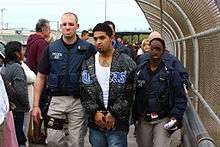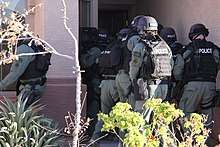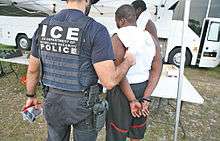U.S. Immigration and Customs Enforcement
| U.S. Immigration and Customs Enforcement | |
|---|---|
|
Logo of the U.S. Immigration and Customs Enforcement | |
 HSI Special Agent badge | |
 Flag of the U.S. Immigration and Customs Enforcement | |
| Abbreviation | ICE |
| Motto | "Protecting National Security and Upholding Public Safety" |
| Agency overview | |
| Formed | March 1, 2003 |
| Preceding agencies |
|
| Employees | 20,000+ (2016) |
| Annual budget | $7.6 billion (2018)[1] |
| Jurisdictional structure | |
| Federal agency | United States |
| Operations jurisdiction | United States |
| Constituting instrument | |
| General nature | • Federal law enforcement |
| Headquarters |
500 12th Street SW Washington, D.C. |
|
| |
| Agency executives |
|
| Parent agency | U.S. Department of Homeland Security |
| Website | |
| ice.gov | |
The U.S. Immigration and Customs Enforcement (ICE) is a law enforcement agency of the federal government of the United States tasked to enforce the immigration laws of the United States and to investigate criminal and terrorist activity of foreign nationals residing in the United States.[2] ICE has two primary components: Homeland Security Investigations (HSI) and Enforcement and Removal Operations (ERO).
ICE is a federal agency under the jurisdiction of the Department of Homeland Security (DHS) charged with the investigation and enforcement of over 400 federal statutes within the United States and also maintains attachés at major U.S. diplomatic missions overseas. ICE does not patrol American borders; rather, that role is performed by the United States Border Patrol, a unit of U.S. Customs and Border Protection, which is a sister agency of ICE.[3][4][5] The former Acting Director of ICE, Thomas Homan, was replaced by Deputy Director Ronald Vitiello on June 30, 2018.[6]
History

U.S. Immigration and Customs Enforcement was formed pursuant to the Homeland Security Act of 2002, following the events of September 11, 2001. With the establishment of the Department of Homeland Security, the functions and jurisdictions of several border and revenue enforcement agencies were combined and consolidated into U.S. Immigration and Customs Enforcement. Consequently, ICE is the largest investigative arm of the Department of Homeland Security, and the second largest contributor to the nation's Joint Terrorism Task Force.
The agencies that were either moved entirely or merged in part into ICE included the investigative and intelligence resources of the United States Customs Service, the criminal investigative, detention and deportation resources of the Immigration and Naturalization Service, and the Federal Protective Service. The Federal Protective Service was later transferred from ICE to the National Protection and Programs Directorate effective October 28, 2009. In 2003, Asa Hutchinson moved the Federal Air Marshals Service from the Transportation Security Administration (TSA) to ICE,[7] but Michael Chertoff moved them back to the TSA in 2005.[8]
Organization
U.S. Immigration and Customs Enforcement is responsible for identifying and eliminating border, economic, transportation, and infrastructure security vulnerabilities. There is an estimate of about more than 20,000 ICE employees in approximately over 400 offices within the United States and 46 other countries.[9]
The organization is composed of two law enforcement directorates and several support divisions each headed by a director who reports to an Executive Associate Director.[10] The divisions of ICE provide investigation, interdiction and security services to the public and other law enforcement partners in the federal and local sectors.
The Director of ICE is appointed at the sub-cabinet level by the President of the United States, confirmed by the U.S. Senate, and reports directly to the Secretary of Homeland Security.[11][12]
Structure
- Director (until July 2010 the title has been "Assistant Secretary")[13]
- Deputy Director
- Enforcement and Removal Operations
- Removal Division
- Secure Communities and Enforcement Division
- Immigration Health Services Division
- Mission Support Division
- Detention Management Division
- Local Field Offices
- Homeland Security Investigations
- Domestic Operations Division
- Intelligence Division
- International Operations Division
- Mission Support
- National Intellectual Property Rights Coordination Center
- National Security Investigations Division
- Management and Administration
- Enforcement and Removal Operations
- Deputy Director
Homeland Security Investigations (HSI)
_training_using_armored_vehicle.jpg)
HSI special agents investigate a range of issues that threaten the national security of the United States such as human rights violations, human smuggling, art theft, human trafficking, drug trafficking, arms trafficking, document and benefit fraud, the manufacturing and sale of counterfeit immigration and identity documents, transnational gangs, financial crimes including money laundering and bulk cash smuggling, trade-based money laundering (including trade finance and Kimberley Process investigations), computer crimes, including the production and transportation of child pornography via the Internet, import/export enforcement, trafficking of counterfeit pharmaceuticals and other merchandise, and international Cultural Property and Antiquities crimes. HSI agents can be requested to provide security for VIPs, and also augment the U.S. Secret Service during overtaxed times such as special security events and elections.
HSI was formerly known as the ICE Office of Investigations (OI). HSI agents have the statutory authority to enforce the Immigration and Nationality Act (Title 8), U.S. customs laws (Title 19), general federal crimes (Title 18), the Controlled Substances Act (Title 21), as well as Titles 5, 6, 12, 22, 26, 28, 31, 46, 49, and 50 of the U.S. Code. HSI has more than 6,500 special agents, making it the largest investigative entity in the Department of Homeland Security and the second largest in the federal government.
Intelligence
The Office of Intelligence is a subcomponent of HSI that employs a variety of special agents and Intelligence Research Specialists to facilitate HSI's tactical and strategic intelligence demands. Collectively, these intelligence professionals collect, analyze, and disseminate intelligence for use by the operational elements of DHS. The Office of Intelligence works closely with the intelligence components of other federal, state, and local agencies. Many HSI field offices assign intelligence analysts to specific groups, such as financial crimes, counter-proliferation, narcotics, or document fraud; or, alternatively, they can be assigned to a residential intelligence unit, known as a Field Intelligence Group (FIG). HSI agents assigned to FIGs generally focus on Human Intelligence (HUMINT) collection.
International Operations

International Operations, formerly known as the Office of International Affairs (OIA), is a subcomponent of HSI with agents stationed in 60 locations around the world. HSI's foreign offices, known as Attaché Offices, work with foreign governments to identify and combat transnational criminal organizations before they threaten the United States. IO also facilitates domestic HSI investigations by providing intelligence from host countries, conducting collateral investigations, and facilitating international investigations conducted by field offices within the United States.
Special Response Teams
Seventeen HSI field offices maintain a Special Response Team (SRT) that operates as a federal SWAT element for the office's area of responsibility (AOR).[14] SRT was founded under the U.S. Customs Service as the Warrant Entry and Tactical Team (WETT) and were renamed to SRT in 1998.[14] The SRT handle HSI's high-risk arrest and search warrants, barricaded subjects, rural area operations, VIP protection, sniper coverage for high-risk operations, and security for National Security Events. HSI's active SRTs are located in Tampa, Miami, Arizona (Phoenix), New Orleans, Houston, New York, Boston, Dallas, Los Angeles, San Antonio, San Juan, Detroit, San Francisco, El Paso, Chicago, San Diego and Washington, D.C. There is also a team of instructors and coordinators stationed full-time in Columbus, Georgia. These teams primarily deploy to handle high-risk operations, but also assist in events such as Hurricane Katrina, the Haiti earthquake 2010, and other natural disasters around the globe.
SRT is a collateral duty open to HSI agents assigned to an office with a certified team. To qualify, candidates must pass a physical fitness test, qualify with multiple firearms by shooting 90% or better in full tactical gear, and pass an oral interview process. If a candidate passes these stages and is voted on the local team, they are then designated "Green Team" members and allowed to train with the certified team members. Green Team members are eventually sent to the SRT Initial Certification Course at the Office of Firearms and Tactical Programs, Tactical Operations Unit (OFTP/TOU)Fort Benning, Georgia, where they must pass additional physical fitness, firearms, scenario-based and written assessments.[15] Out of approximately 6,500 special agents, there are currently only approximately 250 certified SRT members nationwide.
HSI SRTs often conduct training exercises with various federal, state and local teams, and also assist other teams during national events or large-scale operations that require multiple high-risk scenarios to be conducted simultaneously. The working relationship between the SRTs and the U.S. Department of Defense's U.S. Special Operations Command has led to SOCOM providing the SRTs with excess Mine Resistant Ambush Protected Vehicles (MRAPs), firearms, and other gear designed for the U.S. Tier One groups.
Enforcement and Removal Operations (ERO)

ERO is responsible for enforcing the nation's immigration laws and ensuring the departure of removable immigrants from the United States. ERO uses its deportation officers to identify, arrest, and remove immigrants who violate U.S. immigration law. Deportation officers are responsible for the transportation and detention of immigrants in ICE custody to include the removal of immigrants to their country of origin. Deportation officers prosecute immigrants for violations of U.S. immigration and criminal law, monitor cases during deportation proceedings, supervise released immigrants, and remove immigrants from the United States.[16] Deportation officers operate strategically placed Fugitive Operations Teams whose function is to locate, apprehend, and remove immigrants who have absconded from immigration proceedings and remain in the United States with outstanding warrants for deportation. ERO manages the Secure Communities program which identifies removable immigrants located in jails and prisons. Fingerprints submitted as part of the normal criminal arrest and booking process will automatically check both the Integrated Automatic Fingerprint Identification System (IAFIS) of the FBI's Criminal Justice Information Services (CJIS) Division and the Automated Biometric Identification System (IDENT) of the Department of Homeland Security's US-VISIT Program.
ERO was formerly known as the Office of Detention and Removal Operations (DRO).
Office of State, Local and Tribal Coordination (OSLTC)
OSLTC is ICE's primary outreach and communications component for state, local and tribal stakeholders. It is responsible for building and improving relationships, and coordinating activities with state, local, territorial, and tribal law enforcement agencies and through public engagement. It also fosters and sustains relationships with federal, state and local government officials and coordinates ICE ACCESS programs (Agreements of Cooperation in Communities to Enhance Safety and Security).
Office of the Principal Legal Advisor (OPLA)
OPLA provides legal advice, training and services to support the ICE mission and defends the interests of the United States in the administrative and federal courts, including representing the government of foreign nationals for the purpose of removal (previously known as "deportation") process.
Office of Professional Responsibility
OPR is responsible for investigating allegations of misconduct involving employees of ICE. OPR preserves the organizational integrity of U.S. Immigration and Customs Enforcement by impartially, independently and thoroughly investigating allegations of criminal or serious administrative misconduct by ICE employees worldwide. Additionally, OPR inspects and reviews ICE offices, operations and processes so as to provide executive management with independent reviews of the agency's organizational health. In this role, OPR assesses the effectiveness and efficiency of ICE in carrying out its mission.
Former units
The Federal Air Marshal Service (FAMS) was aligned into ICE shortly after the creation of the Department of Homeland Security. On October 16, 2005, Homeland Security Secretary Michael Chertoff officially approved the transfer of the Federal Air Marshal Service from the Bureau of Immigration & Customs Enforcement (ICE) to the TSA as part of a broader departmental reorganization to align functions consistent with the Department of Homeland Security (DHS) "Second Stage Review" findings for:
- consolidating and strengthening aviation law enforcement and security at the Federal level;
- creating a common approach to stakeholder outreach; and
- improving the coordination and efficiency of aviation security operations.
As part of this realignment, the Director of the Federal Air Marshal Service also became the Assistant Administrator for the TSA Office of Law Enforcement (OLE), which houses nearly all TSA law enforcement services.
The Federal Protective Service (FPS) was moved from the General Services Administration (GSA) to ICE upon the creation of the Department of Homeland Security (DHS). The FPS was later moved out of ICE to the National Protection Programs Directorate.
Originally a part of the U.S. Customs Service's Office of Investigations, the Office of Air and Marine (then called the Air and Marine Interdiction Division) was transferred to ICE in 2003 during the creation of the Department of Homeland Security, becoming the Office of Air and Marine Operations. Due in part to a 500 million dollar budgetary dispute between CBP and ICE, in 2004 ICE Air and Marine Operations was transferred to U.S. Customs and Border Protection. CBP Air and Marine still works closely with ICE to support the agency's domestic and international law enforcement operations.[17][18][19][20]
The Office of Detention Policy and Planning was responsible developing and maintaining ICE's National Detention Standards, which set out detailed rules for how immigration detainees were to be treated differently than criminal inmates.[21] In April 2017, President Donald Trump decided to close the office and to stop including the standards in new jail contracts.[21]
Assistant Secretaries and Directors
| No. | Picture | Name | Took office | Left office | President |
|---|---|---|---|---|---|
| Assistant Secretary | |||||
| 1 |  |
Michael J. Garcia | March 2003 | September 2005 | George W. Bush |
| – | John P. Clark Acting |
September 2005 | January 2006 | ||
| 2 |  |
Julie Myers | January 4, 2006 | November 14, 2008 | |
| – |  |
John P. Torres Acting |
November 17, 2008 | May 12, 2009 | |
| Barack Obama | |||||
| Director | |||||
| 3 |  |
John T. Morton | May 12, 2009 | July 31, 2013 | Barack Obama |
| – | John Sandweg Acting |
August 1, 2013 | February 21, 2014 | ||
| – |  |
Thomas Winkowski Acting as Principal Deputy Assistant Secretary |
March 16, 2014 | December 23, 2014 | |
| 4 |  |
Sarah Saldaña | December 23, 2014 | January 20, 2017 | |
| – |  |
Daniel Ragsdale Acting |
January 20, 2017 | January 30, 2017 | Donald Trump |
| – |  |
Thomas Homan Acting |
January 30, 2017 | June 29, 2018 | |
| – |  |
Ronald Vitiello Acting |
June 30, 2018 | ||
Training

Newly hired ICE law enforcement personnel receive their training at the Federal Law Enforcement Training Center in Glynco, Georgia. To meet division specific academic and practical instruction, the ICE Academy varies in length from 4 to 6 months depending on the position. Furthermore, following graduation, all ICE law enforcement personnel undergo additional post academy training, as well as career-continuous training. Specific course curriculum is kept confidential, but both ERO and HSI new hires undergo training related to basic law enforcement tactics, immigration law, firearms training, emergency response driving, and Constitutional law. HSI agents also receive training regarding U.S. customs law, warrant service, advanced tactics, undercover operations, criminal interrogation, weapons of mass destruction, and other subjects routinely encountered by HSI agents in the field. ERO deportation officers undergo several weeks of intensive Spanish language training prior to graduating.
Transnational gangs

In February 2005, ICE began Operation Community Shield, a national law enforcement initiative that targets violent transnational street gangs through the use of ICE's broad law enforcement powers, including the unique and powerful authority to remove criminal immigrants, including illegal immigrants and legal permanent residents.[22][23]
Deportation case samples
- In September 2016, ICE deported Rwanda national Leopold Munyakazi, a suspect of Rwandan genocide.[24]
- January 31, 2018, ICE deported Amer "Al" Adi Othman of Ohio in a "highly irregular rebuke of Congressional Authority" according to Congressman Tim Ryan of Ohio. Othman was deported to Jordan despite having lived in the United States for nearly 40 years, married and having two children. Othman was to be Ryan's guest at the State of the Union Address on January 30, 2018, and due to his ongoing detention, his seat was left empty.[25]
- August 21, 2018 ICE deported Jakiw Palij, who was a Nazi guard at the Trawniki concentration camp. Dubbed by authorities as the last surviving Nazi in the U.S., a judge ordered his deportation in 2004. No country was willing to accept him, until 2018 when Germany accepted him.[26][27]
Immigration law
Immigration and Nationality Act Section 287(g) allows ICE to establish increased cooperation and communication with state, and local law enforcement agencies. Section 287(g) authorizes the Secretary of Homeland Security to enter into agreements with state and local law enforcement agencies, permitting designated officers to perform immigration law enforcement functions, pursuant to a Memorandum of Agreement (MOA), provided that the local law enforcement officers receive appropriate training and function under the supervision of sworn U.S. Immigration and Customs Enforcement officers. Under 287(g), ICE provides state and local law enforcement with the training and subsequent authorization to identify, process, and when appropriate, detain immigration offenders they encounter during their regular, daily law-enforcement activity.[28]
The 287(g) program is extremely controversial; it has been widely criticized for increasing racial profiling by police and undermining community safety because unlawful immigrant communities are no longer willing to report crimes or talk to law enforcement.[29]
The 287(g) program is one of several ICE ACCESS (ICE "Agreements of Cooperation in Communities to Enhance Safety and Security") programs that increase collaboration between local law enforcement and immigration enforcement agents.[30]
ICE has played a key role in investigating and arresting citizens suspected of possessing and distributing child pornography.[31] Because the vast majority of child pornography is produced outside the United States, HSI special agents utilize their authority to investigate persons and groups that traffic in this type of contraband, the importation of which via traditional mail or internet channels constitute violations of customs laws.
Detention centers
ICE operates detention centers throughout the United States that detain illegal aliens who are apprehended and placed into removal proceedings. About 34,000 people are held in immigration detention on any given day,[32] in over 500 detention centers, jails, and prisons nationwide.[33] Due to the United States detention bed quota, mandated by congress, that number will increase rather than decrease. The quota mandates at least 34,000 beds available for immigrants on any given day.[34][35]
In 2006, the T. Don Hutto Residential Center opened specifically to house non-criminal families. Other significant facilities are located in Lumpkin, Georgia; Austin, Texas; Elizabeth, New Jersey; Oakdale, Louisiana; Florence, Arizona; Miami, Florida; Seattle; York, Pennsylvania; Batavia, New York; Aurora, Colorado; Aguadilla, Puerto Rico, and all along the Texas–Mexico border.
| Alabama | Etowah County Detention Center |
|---|---|
| Arizona | Central Arizona Detention Center Eloy Detention Center |
| California | Adelanto Detention Center Contra Costa West County Detention Facility |
| Florida | Baker County Detention Facility Broward Transitional Center |
| Georgia | Atlanta City Detention Center Irwin County Detention Center |
| Illinois | Jefferson County Justice Center McHenry County Jail |
| Iowa | Hardin County Jail |
| Kentucky | Boone County Jail |
| Louisiana | LaSalle Detention Center Oakdale Detention Center |
| Maryland | Worcester County Jail |
| Massachusetts | Bristol County Jail Plymouth County Correctional Facility |
| Michigan | Calhoun County Jail Monroe County Jail |
| Minnesota | Freeborn County Jail Ramsey County Jail |
| New Mexico | Albuquerque Immigration Office |
| Texas | Dallas Immigration Detention Center T. Don Hutto Residential Center |
| Washington | Tacoma Northwest Detention Center |
Deaths in detention
From October 2003 to 2007, a total of 107 deaths occurred in ICE detention centers. In January 2010, The New York Times and the American Civil Liberties Union (ACLU) obtained documents detailing the circumstances of these deaths, under the Freedom of Information Act. "The documents show how officials—some still in key positions—used their role as overseers to cover up evidence of mistreatment, deflect scrutiny by the news media or prepare exculpatory public statements after gathering facts that pointed to substandard care or abuse," The New York Times reported.[37] The deaths in detention included the following cases:
- Boubacar Bah, a 52-year-old tailor from Guinea, was left in an isolation cell for more than 13 hours after falling and suffering a head fracture before an ambulance was called. His family was not notified for five days of his injury.[38] A video shows Bah in the medical unit, before medical personnel sent him to the isolation cell. In the tape, his hands are handcuffed behind his back, he is face down, and he calls out repeatedly in his native language, Fulani: "Help, they are killing me!" Telephone and email records show that ten agency managers based in Newark and Washington discussed how to avoid the cost of his care and unwanted media attention. They considered sending Bah back to Guinea and reviewing his canceled work permit to see if it would be possible to get Medicaid or disability benefits. Eventually, they decided to release him to cousins in New York who objected that they had no way to care for Bah; however, days before this release was planned, Bah died.[37]
- Nery Romero was a 22-year-old Salvadoran immigrant with no previous history of mental illness who committed suicide in his cell in the Bergen County Jail in New Jersey. At the time of his detention, he was recovering from surgery in which metal pins had been placed in his leg, seriously broken in a motorcycle accident, and was taking strong prescription painkillers. According to Romero's cellmates and family, authorities failed to provide Romero with painkillers despite his repeated requests.[37] In a letter written to his mother shortly before his death, Romero stated: "I'm in hell. They don't give me nothing for my pain."[39]
- Sandra Kenley of Barbados, who did not receive treatment for a uterine fibroid tumor, died at the Hampton Roads Regional Jail in Portsmouth, Virginia in December 2006. An autopsy determined the cause of her death was acute coronary insufficiency due to hypertensive cardiovascular disease.[40][39]
- Abdoulai Sali died of an untreated kidney ailment in the Piedmont Regional Jail in Virginia.[39]
- Young Sook Kim died at the New Mexico Regional Jail in Albuquerque of pancreatic cancer in September 2006. She had asked for weeks to receive medical care, and died the day after she was taken to a hospital.[41]
Corporate contracts
Engineering and construction firm Kellogg, Brown and Root (KBR) released a press statement on January 24, 2006, that the company had been awarded a no-bid contingency contract from the Department of Homeland Security to support its ICE facilities in the event of an emergency. The maximum total value of the contract is $385 million and consists of a one-year base period with four one-year options. KBR held the previous ICE contract from 2000 through 2005. The contract provides for establishing temporary detention and processing capabilities to expand existing ICE Detention and Removal Operations Program facilities in the event of an emergency influx of immigrants into the U.S., or to support the rapid development of new programs. The contract may also provide migrant detention support to other government organizations in the event of an immigration emergency, the company said.
ICE Air
ICE Air is the aviation division of ICE that charters aircraft or books commercial flights to send deportees back to their home countries.[42] There are 10 aircraft used to send deportees and has a working list of 185 countries.[42]
Deportees have legs and arms secured while boarding, handcuffs are removed during flight and all shackles removed upon disembarking.
Criticisms
Sexual abuse
The Intercept published a report by the DHS Office of Inspector General revealing that 1,224 sexual abuse complaints while in immigration custody were filed between January 2010 and June 2017. Contrary to ICE's claims, only 2% of these complaints were investigated.[43]
Record number of deportations
Between 2009 and 2016, the Barack Obama administration oversaw the deporting of a record 2.4 million immigrants, earning him the nickname "Deporter-In-Chief" by Janet Murguía, the president of National Council of La Raza.[44][45] According to ICE data, about 40% of those deported by ICE in 2015 had no criminal conviction, while majority of those convicted were guilty of minor charges.[46]
Separation of migrant children from their families

As part of the 2018 Trump administration's zero tolerance policy, nearly 3,000[47] minors were separated from their parents while trying to illegally cross the U.S.-Mexico border and placed in detention centers.[48][49] Rolling Stone likened these centers to "prisons" while The Houston Chronicle reported that a movement swelled online to call them "concentration camps."[50][51] Similarly, former First Lady of the United States Laura Bush compared the images of the centers to U.S. Japanese internment camps during the Second World War.[52] 16 out of 34[53] of the centers located in Texas had previously been cited by Texas officials for more than 150 health violations.[54] The former head of US Immigration and Customs Enforcement, John Sandweg, was critical of child separation, telling NBC News, "You could easily end up in a situation where the gap between a parent's deportation and a child's deportation is years," and that many children might never see their parents again.[55]
See also
- Asylum shopping
- Diplomatic Security Service (DSS)—U.S. Department of State
- Drug Enforcement Administration
- Federal Air Marshal Service
- Federal Bureau of Investigation
- Federal crime
- Federal Protective Service (U.S.)
- Illegal drug trade in the United States
- List of United States federal law enforcement agencies
- Office of Air and Marine
- Operation Endgame
- Operation Front Line
- Operation Protect Our Children
- Operation Tangled Web
- Shadow Wolves
- Title 19 of the Code of Federal Regulations
- United States Border Patrol
- U.S. Customs and Border Protection
- United States Citizenship and Immigration Services
- U.S. Marshals Service
- U.S. Postal Inspection Service
- U.S. Secret Service
- Jaime Zapata (U.S. agent)
Comparable international agencies
- Australian Border Force
- Canada Border Services Agency
- Immigration Enforcement - a Home Office command in the United Kingdom
- Customs Surveillance Service—Spain (only customs enforcement; immigration issues are handled by the standard National Police and Guardia Civil)
- Frontex—European Union (Schengen Area)
- Federal Migration Service (FMS)—Russia
References
- ↑ "Strengthening Border Security: An American Budget" (PDF). The White House. Retrieved 12 May 2018.
- ↑ "What We Do | ICE". U.S. Immigration and Customs and Enforcement. Department of Homeland Security. Retrieved 30 July 2018.
- ↑ "What Is ICE and Why Do Critics Want to Abolish It?". Retrieved July 5, 2018.
- ↑ "Calls to Abolish ICE Not 'Open Borders' - FactCheck.org". July 3, 2018. Retrieved July 5, 2018.
- ↑ Folley, Aris (June 29, 2018). "ICE chief to protesters: We're not the ones separating families". Retrieved July 5, 2018.
- ↑ Talev, Margaret (June 30, 2018). "Vitiello Tapped as Acting ICE Director". Bloomberg.
He's being named the deputy director of ICE and will also will serve as its acting director, Homeland Security Kirstjen Nielsen said in a statement on Saturday.
- ↑ Goo, Sara Kehaulani; Goo, Sara Kehaulani (June 19, 2003). "Air Marshals Seek a Flight Out of TSA to New Agency" – via washingtonpost.com.
- ↑ ""The Federal Air Marshal Service will be moved from the Immigration and Customs Enforcement (ICE) bureau to the Transportation Security Administration"".
- ↑ "Who We Are | ICE". Ice.gov. 2016-03-25. Retrieved 2017-06-14.
- ↑ "ICE Leadership". Ice.gov. January 1, 1970. Retrieved September 27, 2010.
- ↑ "Leadership: Assistant Secretary John T. Morton". U.S. Immigration and Customs Enforcement. May 21, 2009. Archived from the original on May 27, 2010. Retrieved August 9, 2009.
- ↑ "Leadership". U.S. Immigration and Customs Enforcement. June 21, 2014. Retrieved June 21, 2014.
- ↑ "John T. Morton is appointed assistant secretary of U.S. Immigration and Customs Enforcement". U.S. Immigration and Customs Enforcement. Retrieved June 25, 2017.
- 1 2 James, Nathan (3 September 2015). Federal Tactical Teams (Report). Congressional Research Service. CRS Report for Congress, R44179.
- ↑ "Special response teams prep for high risk situations at Ft. Benning". U.S. Immigration and Customs Enforcement (Press release). 30 November 2011. Retrieved 12 September 2017.
- ↑ "ICE Office of Detention and Removal (ERO) ICE Detention and Deportation Officer Conrad Agagan". Ice.gov. Archived from the original on May 27, 2010. Retrieved September 27, 2010. {
- ↑ "2000 Archived Press Releases". Customs and Border Protection. March 16, 2001. Archived from the original on December 23, 2004. Retrieved June 18, 2013.
- ↑ "Management Mess – Features – Magazine". GovExec.com. March 1, 2006. Retrieved 2013-06-18.
- ↑ "CBP Today – October/November 2004 – Welcome Air and Marine Operations". Customs and Border Protection. October 31, 2004. Archived from the original on October 23, 2011. Retrieved June 18, 2013.
- ↑ "Wasted Year". GovExec.com. March 2006. Retrieved 2013-06-18.
- 1 2 Dickerson, Caitlin (14 April 2017). "Trump Plan Would Curtail Protections for Detained Immigrants". The New York Times. p. A1. Retrieved 15 April 2017.
- ↑ Office of Investigations-Operation Community Shield Archived May 5, 2009, at the Wayback Machine.
- ↑ "Operation targets criminal immigrant gangs". msnbc.com. 2006-03-11. Retrieved 2018-07-23.
- ↑ "US deports Rwanda genocide suspect Leopold Munyakazi". BBC News. 28 September 2016.
- ↑ "Youngstown businessman Amer Othman Adi deported to Jordan". Cleveland.com. Retrieved July 5, 2018.
- ↑ Durkin, Erin (2018-08-22). "'It finally happened': the long fight to expel America's last known Nazi". the Guardian. Retrieved 2018-08-22.
- ↑ "US deports Nazi camp guard to Germany". BBC News. 2018-08-21. Retrieved 2018-08-22.
- ↑ Budzinski, Joe (September 30, 2006). "287g training from ICE sought by many U.S. jurisdictions – novatownhall blog". Novatownhall.com. Retrieved September 27, 2010.
- ↑ "Advocates Condemn Obama Administration's Expansion of DHS's Failed 287(g) Program – Center for Media Justice". pitchengine.com. July 17, 2009. Retrieved September 27, 2010.
- ↑ "Office of State and Local Coordination: ICE ACCESS". Ice.gov. Archived from the original on May 27, 2010. Retrieved September 27, 2010.
- ↑ "Teacher faces charges of pornography". MassLive.com. November 29, 2006. Archived from the original on March 7, 2012. Retrieved September 27, 2010.
- ↑ Bernstein, Nina. "In-Custody Deaths". New York Times. Retrieved May 26, 2010.
- ↑ Anil Kalhan (2010). "Rethinking Immigration Detention". Columbia Law Review Sidebar. 110: 42–58. SSRN 1556867.
- ↑ "Detention Bed Quota". National Immigrant Justice Center. Retrieved July 5, 2018.
- ↑ "Little-Known Immigration Mandate Keeps Detention Beds Full". NPR.org. Retrieved 2018-06-11.
- ↑ "Detention Facility Locator". Retrieved 12 September 2018.
- 1 2 3 Nina Bernstein (January 10, 2010). "Officials Hid Truth About Immigrant Deaths in Jail". The New York Times. Retrieved January 10, 2010.
- ↑ Nina Bernstein (May 5, 2008). "Few Details on Immigrants Who Died in Custody". New York Times. Retrieved January 10, 2010.
- 1 2 3 "Documents: Deaths in Immigration Detention". The New York Times. January 10, 2010. Retrieved January 10, 2010.
- ↑ Bryant, Janie. "Sister files suit over care of detainee who died in jail". Retrieved July 5, 2018.
- ↑ Nina Bernstein (June 26, 2007). "Deaths of immigrants in U.S. held for deportation spark scrutiny". New York Times. Retrieved January 10, 2010.
- 1 2 "A rare look inside a deportation flight – CNN Video".
- ↑ "Immigration detention and sexual abuse". Retrieved 2018-06-15.
- ↑ "Low-Priority Immigrants Still Swept Up in Net of Deportation". The New York Times. June 25, 2016. Retrieved June 15, 2018.
- ↑ "National Council Of La Raza Dubs Obama 'Deporter-In-Chief'". NPR. March 4, 2014. Retrieved June 15, 2018.
- ↑ Young, Elliott (February 27, 2017). "The Hard Truths About Obama's Deportation Priorities". HuffPost. Retrieved June 15, 2018.
- ↑ "The Trump administration just admitted it doesn't know how many kids are still separated from their parents". Vox. Retrieved 2018-07-06.
- ↑ Touchberry, Ramsey (June 15, 2018). "Almost 45 children a day are being taken from their families and placed in immigrant detention centers: Report". Newsweek.
- ↑ Kendzior, Sarah (17 June 2018). "The unspeakable cruelty of Trump's child-migrant camps". The Globe and Mail. Retrieved 19 June 2018.
- ↑ Bort, Ryan (14 June 2018). "This Is the Prison-Like Border Facility Holding Migrant Children". Rolling Stone. Retrieved 19 June 2018.
- ↑ Ramirez, Fernando (June 15, 2018). "Movement to call migrant detention centers 'concentration camps' swells online". The Houston Chronicle.
- ↑ Bush, Laura (2018-06-17). "Opinion Laura Bush: Separating children from their parents at the border 'breaks my heart'". Washington Post. ISSN 0190-8286. Retrieved 2018-06-19.
- ↑ "Shelters for immigrant children near capacity in Texas". KHOU. Retrieved 2018-06-19.
- ↑ Touchberry, Ramsey (June 12, 2018). "Texas immigrant children shelters had 150 health violations in the past year". Newsweek.
- ↑ Joseph, Rebecca (June 19, 2018). "Separations of children, parents at U.S. border could be permanent: Former immigration director". GlobalNews.
External links
| Wikimedia Commons has media related to U.S. Immigration and Customs Enforcement. |
- Official website
- U.S. Immigration and Customs Enforcement in the Federal Register
- U.S. Customs and Border Protection
- International agencies comparable to ICE
